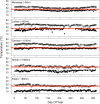Environmental temperatures significantly change the impact of insecticides measured using WHOPES protocols
- PMID: 25187231
- PMCID: PMC4162960
- DOI: 10.1186/1475-2875-13-350
Environmental temperatures significantly change the impact of insecticides measured using WHOPES protocols
Abstract
Background: Insecticides are critical components of malaria control programmes. In a variety of insect species, temperature plays a fundamental role in determining the outcome of insecticide exposure. However, surprisingly little is known about how temperature affects the efficacy of chemical interventions against malaria vectors.
Methods: Anopheles stephensi, with no recent history of insecticide exposure, were exposed to the organophosphate malathion or the pyrethroid permethrin at 12, 18, 22, or 26°C, using the WHO tube resistance-monitoring assay. To evaluate the effect of pre-exposure temperature on susceptibility, adult mosquitoes were kept at 18 or 26°C until just before exposure, and then moved to the opposite temperature. Twenty-four hours after exposure, mosquitoes exposed at <26°C were moved to 26°C and recovery was observed. Susceptibility was assessed in terms of survival 24 hours after exposure; data were analysed as generalized linear models using a binomial error distribution and logit link function.
Results: Lowering the exposure temperature from the laboratory standard 26°C can strongly reduce the susceptibility of female An. stephensi to the WHO resistance-discriminating concentration of malathion (χ2(df=3) = 29.0, p < 0.001). While the susceptibility of these mosquitoes to the resistance-discriminating concentration of permethrin was not as strongly temperature-dependent, recovery was observed in mosquitoes moved from 12, 18 or 22°C to 26°C 24 hours after exposure. For permethrin especially, the thermal history of the mosquito was important in determining the ultimate outcome of insecticide exposure for survival (permethrin: pre-exposure temperature: F1,29 = 14.2, p < 0.001; exposure temp: F1,29 = 1.1, p = 0.3; concentration: F1,29 = 85.2, p < 0.001; exposure temp x conc: F1,29 = 5.8, p = 0.02). The effect of acclimation temperature on malathion susceptibility depended on the exposure temperature (exposure temp: F1,79 = 98.4, p < 0.001; pre-exposure temp: F1,79 = 0.03, p = 0.9; pre-exp temp x exp temp F1,79 = 6.0, p = 0.02).
Conclusions: A single population of An. stephensi could be classified by WHO criteria as susceptible or resistant to a given chemical, depending on the temperature at which the mosquitoes were exposed. Investigating the performance of vector control tools under different temperature conditions will augment the ability to better understand the epidemiological significance of insecticide resistance and select the most effective products for a given environment.
Figures








Similar articles
-
Insecticide susceptibility status of Anopheles gambiae (s.l.) in South-West Cameroon four years after long-lasting insecticidal net mass distribution.Parasit Vectors. 2018 Jul 4;11(1):391. doi: 10.1186/s13071-018-2979-1. Parasit Vectors. 2018. PMID: 29973260 Free PMC article.
-
Current insecticide susceptibility status of Malaysian Anopheles maculatus Theobald to malathion, permethrin, DDT and deltamethrin.Trop Biomed. 2014 Mar;31(1):159-65. Trop Biomed. 2014. PMID: 24862056
-
Efficacy of three insecticides against Anopheles dirus and Anopheles minimus, the major malaria vectors, in Kanchanaburi Province, Thailand.Southeast Asian J Trop Med Public Health. 2012 Nov;43(6):1339-45. Southeast Asian J Trop Med Public Health. 2012. PMID: 23413696
-
Pyrethroid resistance in the major malaria vector Anopheles arabiensis from Gwave, a malaria-endemic area in Zimbabwe.Malar J. 2008 Nov 28;7:247. doi: 10.1186/1475-2875-7-247. Malar J. 2008. PMID: 19038063 Free PMC article.
-
Investigating the molecular basis of multiple insecticide resistance in a major malaria vector Anopheles funestus (sensu stricto) from Akaka-Remo, Ogun State, Nigeria.Parasit Vectors. 2020 Aug 18;13(1):423. doi: 10.1186/s13071-020-04296-8. Parasit Vectors. 2020. PMID: 32811561 Free PMC article.
Cited by
-
Unpacking WHO and CDC Bottle Bioassay Methods: A Comprehensive Literature Review and Protocol Analysis Revealing Key Outcome Predictors.Gates Open Res. 2024 Jun 4;8:56. doi: 10.12688/gatesopenres.15433.1. eCollection 2024. Gates Open Res. 2024. PMID: 39170853 Free PMC article. Review.
-
Modelling the impact of declining insecticide resistance with mosquito age on malaria transmission.Malariaworld J. 2015 Nov 14;6:13. doi: 10.5281/zenodo.10876461. eCollection 2015. Malariaworld J. 2015. PMID: 38779631 Free PMC article.
-
Complete series method (CSM): a convenient method to reduce daily heterogeneity when evaluating the regeneration time (RT) of insecticide-treated nets (ITNs).Parasit Vectors. 2024 May 22;17(1):235. doi: 10.1186/s13071-024-06323-4. Parasit Vectors. 2024. PMID: 38778423 Free PMC article.
-
Insights and challenges of insecticide resistance modelling in malaria vectors: a review.Parasit Vectors. 2024 Apr 3;17(1):174. doi: 10.1186/s13071-024-06237-1. Parasit Vectors. 2024. PMID: 38570854 Free PMC article. Review.
-
Temperature, mosquito feeding status and mosquito density influence the measured bio-efficacy of insecticide-treated nets in cone assays.Parasit Vectors. 2024 Mar 28;17(1):159. doi: 10.1186/s13071-024-06210-y. Parasit Vectors. 2024. PMID: 38549097 Free PMC article.
References
-
- WHO . World Malaria Report 2012. pp. 293. Geneva: World Health Organization; 2012. p. 293.
-
- WHO . Test procedures for insecticide resistance monitoring in malaria vectors, bio-efficacy and persistence of insecticide on treated surfaces. Geneva, Switzerland: World Health Organization; 1998.
Publication types
MeSH terms
Substances
Grants and funding
LinkOut - more resources
Full Text Sources
Other Literature Sources
Miscellaneous

